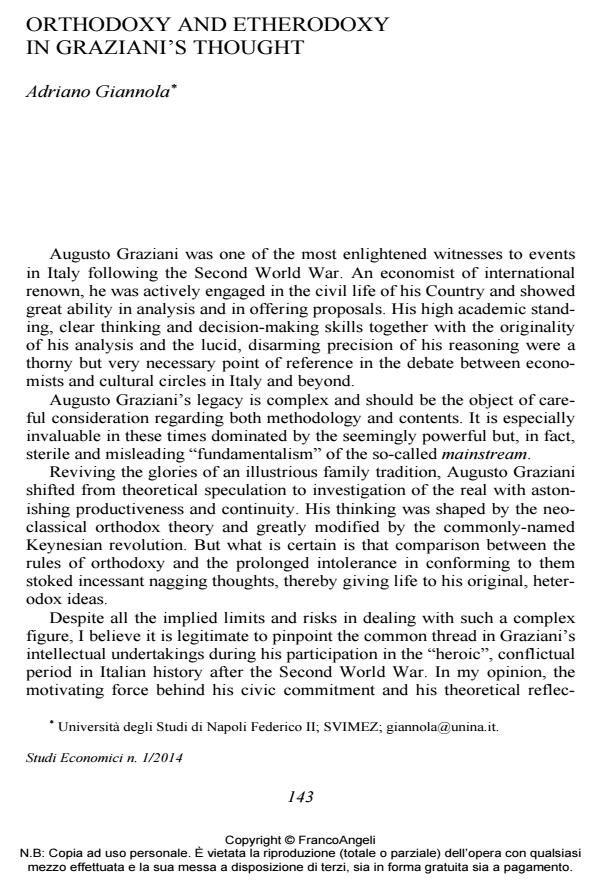Orthodoxy and etherodoxy in graziani’s thought
Titolo Rivista STUDI ECONOMICI
Autori/Curatori Adriano Giannola
Anno di pubblicazione 2015 Fascicolo 2014/112
Lingua Inglese Numero pagine 13 P. 143-155 Dimensione file 52 KB
DOI 10.3280/STE2014-112011
Il DOI è il codice a barre della proprietà intellettuale: per saperne di più
clicca qui
Qui sotto puoi vedere in anteprima la prima pagina di questo articolo.
Se questo articolo ti interessa, lo puoi acquistare (e scaricare in formato pdf) seguendo le facili indicazioni per acquistare il download credit. Acquista Download Credits per scaricare questo Articolo in formato PDF

FrancoAngeli è membro della Publishers International Linking Association, Inc (PILA)associazione indipendente e non profit per facilitare (attraverso i servizi tecnologici implementati da CrossRef.org) l’accesso degli studiosi ai contenuti digitali nelle pubblicazioni professionali e scientifiche
This contribution attempts to evaluate Augusto Graziani’s legacy. His thinking, shaped by the neoclassical orthodoxy, and by Keynes’ work, has structured an original, heterodox framework. His heterodoxy, was marked by the progressive overcoming of the concept of equilibrium, looking for a "possible equilibrium", which did not legitimize the concept of "naturalness" or, even less, that of classical full employment of the General Equilibrium approach. Dynamics is the "core" of his analysis which considers relevant to deal with development, as opposed to the static approach of growth. In this perspective, banks-firms nexus in a monetary theory of production is crucial to reach an "unqualified equilibrium". Coming to real world, the need to govern the economy through a process of development brings back to our dualism. His lucid analysis of the Italian experience reveals his profound reformist commitment and his well grounded distrust of the healing miracle entrusted to market mechanisms.
Parole chiave:Augusto Graziani, General equilibrium theory, Economic models, Italian Economy
Jel codes:B3, B5, O1
- Becattini G. (1998), “La leggera industria del Mezzogiorno”, “Distretti meridionali”, Dibattito sul Mezzogiorno, Il Manifesto, March 6, 7.
- Becattini G. (2001), Il caleidoscopio dello sviluppo locale. Contributo a un dibattito napoletano, in Quaderni dell’Archivio Storico. Supplemento, Istituto Banco di Napoli Fondazione, Napoli, pp. 109-151.
- CENSIS (1981), La nuova geografia socio-economica del Mezzogiorno, Roma.
- Graziani A. (1962), “I criteri di scelta negli investimenti pubblici” lectures in Corso di for mazione e specializzazione sui problemi della teoria e della politica dello sviluppo economico, SVIMEZ, Roma.
- Graziani A. (1964), Sviluppo del Mezzogiorno e produttività delle risorse , ESI, Napoli.
- Graziani A. (1965), Equilibrio generale ed equilibrio macroeconomico, ESI, Napoli.
- Graziani A. (ed.) (1969), Lo sviluppo di un’economia aperta, Franco Angeli, Milano.
- Graziani A. (1972), L’economia Italiana, 1945-1970, Il Mulino, Bologna; Last edition
- (2000), Lo sviluppo dell’economia italiana dalla ricostruzione alla moneta europea, Il Mulino, Bologna.
- Graziani A., Meloni F. (1973), Inflazione e fluttuazione della lira, “Note Economiche”, anno VI, 3, pp. 46-83.
- Graziani A. (ed.) (1975), Crisi e ristrutturazione nell’economia italiana, Einaudi, Torino.
- Graziani A. (1978), The Mezzogiorno in the Italian Economy, “Cambridge Journal of Economics”, vol. 2, 4, pp. 355-372.
- Graziani A. (1984), Moneta senza crisi, “Studi Economici”, anno XXXIX, 3, pp. 3-37.
- Graziani A. (1989), Il Mezzogiorno e l’economia italiana, in A. Giannola (a cura di), L’economia e il Mezzogiorno. Sviluppo, imprese e territorio, Franco Angeli, Milano, pp. 15-45.
- Graziani A. (1994), La teoria monetaria della produzione, Banca Popolare dell’Etruria, Arezzo.
- Graziani A. (1997), I conti senza l’oste, Bollati Boringhieri, Torino.
- Graziani A. (1998), “Il paese senza ciminiere”, Dibattito sul Mezzogiorno, Il Manifesto, February 25.
- Graziani A. (2003), The Monetary Theory of Production, Cambridge University Press, Cambridge.
- Il Manifesto (1998), Dibattito sul Mezzogiorno, (February 25; March, 5, 6, 7,10, 17,18. Notes by Augusto Graziani, Enrico Pugliese, Giacomo Becattini, Adriano Giannola).
- Roseinstein-Rodan P.N. (1943), Problems of Industrialisation of Eastern and South – Eastern Europe, “The Economic Journal”, vol. 53, June-September, pp. 202-211.
- Sylos Labini P. (1985), L’evoluzione economica del Mezzogiorno negli ultimi trent’anni, Studi SVIMEZ n.1, Roma.
Adriano Giannola, Orthodoxy and etherodoxy in graziani’s thought in "STUDI ECONOMICI " 112/2014, pp 143-155, DOI: 10.3280/STE2014-112011